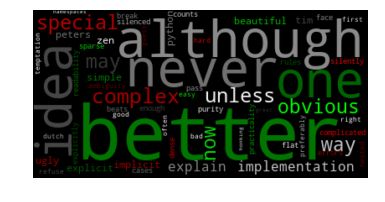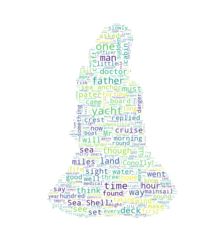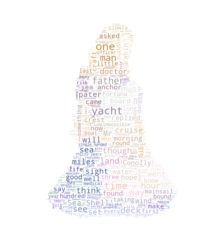整体简介:
词云图,也叫文字云,是对文本中出现频率较高的“关键词”予以视觉化的展现,词云图过滤掉大量的低频低质的文本信息,使得浏览者只要一眼扫过文本就可领略文本的主旨。
基于Python的词云生成类库,很好用,而且功能强大。在做统计分析的时候有着很好的应用,比较推荐。
github:https://github.com/amueller/word_cloud
官方地址:https://amueller.github.io/word_cloud/
快速生成词云:
#导入所需库 from wordcloud import WordCloud f = open(r'C:\Users\JluTIger\Desktop\texten.txt','r').read() wordcloud = WordCloud(background_color="white",width=1000, height=860, margin=2).generate(f) # width,height,margin可以设置图片属性 # generate 可以对全部文本进行自动分词,但是对中文支持不好 # 可以设置font_path参数来设置字体集 #background_color参数为设置背景颜色,默认颜色为黑色
import matplotlib.pyplot as plt plt.imshow(wordcloud) plt.axis("off") plt.show() wordcloud.to_file('test.png') # 保存图片,但是在第三模块的例子中 图片大小将会按照 mask 保存
- 运行时遇到的问题:
报错:(unicode error) 'unicodeescape' codec can't decode bytes in position 2-3: truncated \UXXXXXXXX escap
- 原因及解决办法:
文档我是放在桌面里的,起初读取文档的命令是:f = open('C:\Users\JluTIger\Desktop\texten.txt','r').read()
一直报错:(unicode error) 'unicodeescape' codec can't decode bytes in position 2-3: truncated \UXXXXXXXX escape
后来发现,在Python中\是转义符,\u表示其后是UNICODE编码,因此\User在这里会报错,在字符串前面加个r表示就可以了
- 效果:
自定义字体颜色:
下段代码来自wordcloud官方的github。
#!/usr/bin/env python """ Colored by Group Example ======================== Generating a word cloud that assigns colors to words based on a predefined mapping from colors to words 基于颜色到单次的映射,将颜色分配给单次,生成词云。 """ from wordcloud import (WordCloud, get_single_color_func) import matplotlib.pyplot as plt class SimpleGroupedColorFunc(object): """Create a color function object which assigns EXACT colors to certain words based on the color to words mapping 创建一个颜色函数对象,它根据颜色到单词的映射关系,为单词分配精准的颜色。 Parameters 参数 ---------- color_to_words : dict(str -> list(str)) A dictionary that maps a color to the list of words. default_color : str Color that will be assigned to a word that's not a member of any value from color_to_words. """ def __init__(self, color_to_words, default_color): self.word_to_color = {word: color for (color, words) in color_to_words.items() for word in words} self.default_color = default_color def __call__(self, word, **kwargs): return self.word_to_color.get(word, self.default_color) class GroupedColorFunc(object): """Create a color function object which assigns DIFFERENT SHADES of specified colors to certain words based on the color to words mapping. Uses wordcloud.get_single_color_func Parameters ---------- color_to_words : dict(str -> list(str)) A dictionary that maps a color to the list of words. default_color : str Color that will be assigned to a word that's not a member of any value from color_to_words. """ def __init__(self, color_to_words, default_color): self.color_func_to_words = [ (get_single_color_func(color), set(words)) for (color, words) in color_to_words.items()] self.default_color_func = get_single_color_func(default_color) def get_color_func(self, word): """Returns a single_color_func associated with the word""" try: color_func = next( color_func for (color_func, words) in self.color_func_to_words if word in words) except StopIteration: color_func = self.default_color_func return color_func def __call__(self, word, **kwargs): return self.get_color_func(word)(word, **kwargs) #text是要分析的文本内容 text = """The Zen of Python, by Tim Peters Beautiful is better than ugly. Explicit is better than implicit. Simple is better than complex. Complex is better than complicated. Flat is better than nested. Sparse is better than dense. Readability counts. Special cases aren't special enough to break the rules. Although practicality beats purity. Errors should never pass silently. Unless explicitly silenced. In the face of ambiguity, refuse the temptation to guess. There should be one-- and preferably only one --obvious way to do it. Although that way may not be obvious at first unless you're Dutch. Now is better than never. Although never is often better than *right* now. If the implementation is hard to explain, it's a bad idea. If the implementation is easy to explain, it may be a good idea. Namespaces are one honking great idea -- let's do more of those!""" # Since the text is small collocations are turned off and text is lower-cased wc = WordCloud(collocations=False).generate(text.lower()) # 自定义所有单词的颜色 color_to_words = { # words below will be colored with a green single color function '#00ff00': ['beautiful', 'explicit', 'simple', 'sparse', 'readability', 'rules', 'practicality', 'explicitly', 'one', 'now', 'easy', 'obvious', 'better'], # will be colored with a red single color function 'red': ['ugly', 'implicit', 'complex', 'complicated', 'nested', 'dense', 'special', 'errors', 'silently', 'ambiguity', 'guess', 'hard'] } # Words that are not in any of the color_to_words values # will be colored with a grey single color function #不属于上述设定的颜色词的词语会用灰色来着色 default_color = 'grey' # Create a color function with single tone # grouped_color_func = SimpleGroupedColorFunc(color_to_words, default_color) # Create a color function with multiple tones grouped_color_func = GroupedColorFunc(color_to_words, default_color) # Apply our color function # 如果你也可以将color_func的参数设置为图片,详细的说明请看 下一部分 wc.recolor(color_func=grouped_color_func) # 画图 plt.figure() plt.imshow(wc, interpolation="bilinear") plt.axis("off") plt.show()
- 效果:
利用背景图片生成词云,设置停用词词集:
该段代码主要来自于wordcloud的github,你同样可以在github下载该例子以及原图片与效果图。wordcloud会把背景图中白色区域去除,只在有色区域进行绘制。
#!/usr/bin/env python """ Image-colored wordcloud ======================= You can color a word-cloud by using an image-based coloring strategy implemented in ImageColorGenerator. It uses the average color of the region occupied by the word in a source image. You can combine this with masking - pure-white will be interpreted as 'don't occupy' by the WordCloud object when passed as mask. If you want white as a legal color, you can just pass a different image to "mask", but make sure the image shapes line up. """ #导入必要的库 from os import path from PIL import Image import numpy as np import matplotlib.pyplot as plt from wordcloud import WordCloud, STOPWORDS, ImageColorGenerator # Read the whole text. text = open(r'C:\Users\JluTIger\Desktop\texten.txt').read() # read the mask / color image taken from # http://jirkavinse.deviantart.com/art/quot-Real-Life-quot-Alice-282261010 alice_coloring = np.array(Image.open(r"C:\Users\JluTIger\Desktop\alice.png")) # 设置停用词 stopwords = set(STOPWORDS) stopwords.add("said") # 你可以通过 mask 参数 来设置词云形状 wc = WordCloud(background_color="white", max_words=2000, mask=alice_coloring, stopwords=stopwords, max_font_size=40, random_state=42) # generate word cloud wc.generate(text) # create coloring from image image_colors = ImageColorGenerator(alice_coloring) # show # 在只设置mask的情况下,你将会得到一个拥有图片形状的词云 plt.imshow(wc, interpolation="bilinear") plt.axis("off") plt.figure() # recolor wordcloud and show # we could also give color_func=image_colors directly in the constructor # 我们还可以直接在构造函数中直接给颜色 # 通过这种方式词云将会按照给定的图片颜色布局生成字体颜色策略 plt.imshow(wc.recolor(color_func=image_colors), interpolation="bilinear") plt.axis("off") plt.figure() plt.imshow(alice_coloring, cmap=plt.cm.gray, interpolation="bilinear") plt.axis("off") plt.show()
- 请注意自己的路径设置
- 原图
- 效果:




